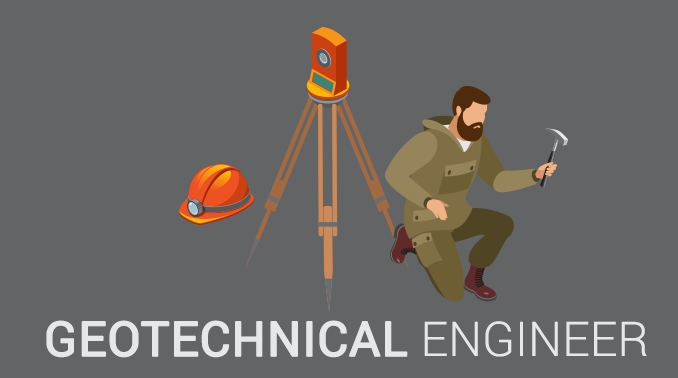Geotheta for Dummies
Geotheta for Dummies
Blog Article
Everything about Geotheta
Table of ContentsThe Main Principles Of Geotheta The Facts About Geotheta RevealedGeotheta Fundamentals ExplainedGeotheta Can Be Fun For AnyoneUnknown Facts About Geotheta

They perform site examinations, collect examples, execute lab examinations, and analyze data to evaluate the suitability of the ground for building and construction jobs - Geo Tech Engineer. Based on their searchings for, geotechnical designers provide referrals for foundation style, incline security, preserving structures, and reduction of geotechnical threats. They collaborate with other experts, such as engineers, structural designers, and construction teams, to make certain that geotechnical considerations are integrated into the total project design and application
By analyzing the behavior and residential properties of dirt and rock, they can recognize possible geotechnical threats such as landslides, soil negotiation, or incline instability. Their knowledge helps stop failings or crashes that could threaten lives and residential property. Here are some comprehensive tasks and obligations of a geotechnical engineer: Website Investigation: Geotechnical engineers conduct website investigations to gather information on subsurface conditions.
They interpret the information to understand the residential or commercial properties and actions of the dirt and rock, including their strength, leaks in the structure, compaction qualities, and groundwater problems. Geotechnical Evaluation and Layout: Geotechnical engineers evaluate the data gathered throughout website examinations to assess the stability and suitability of the site for building jobs. They execute geotechnical estimations and modeling to assess aspects such as birthing capacity, negotiation, incline stability, side planet stress, and groundwater circulation.
Geotheta Fundamentals Explained
Foundation Design: Geotechnical designers play a crucial function in developing foundations that can securely support the desired framework. They examine the dirt conditions and tons demands to determine the proper structure kind, such as superficial structures (e.g., grounds), deep structures (e.g (https://www.merchantcircle.com/blogs/geotheta-miami-fl/2024/8/Why-Geotechnical-Engineers-at-Geotheta-Are-Your-Best-Bet/2781881)., stacks), or specialized strategies like soil improvement. They take into consideration aspects such as negotiation limitations, bearing capacity, and soil-structure interaction to develop optimum structure styles
They evaluate construction strategies, display site activities, and conduct area examinations to validate that the design recommendations are adhered to. If unpredicted geotechnical problems develop, they evaluate the situation and offer recommendations for removal or modifications to the design. Threat Analysis and Mitigation: Geotechnical engineers analyze geotechnical risks and dangers associated with the project site, such as landslides, liquefaction, or dirt disintegration.

Collaboration and Interaction: Geotechnical engineers work very closely with various other experts included in a job, such as architects, architectural designers, and building and construction groups. Reliable interaction and collaboration are important to incorporate geotechnical factors to consider right into the general project style and building and construction procedure. Geotechnical engineers give technical know-how, response questions, and make certain that geotechnical needs are fulfilled.
The Buzz on Geotheta
Here are some kinds of geotechnical designers: Foundation Designer: Foundation engineers focus on designing and assessing structures for frameworks. They examine the soil problems, load demands, and website qualities to determine one of the most suitable structure kind hop over to here and style, such as superficial foundations, deep foundations, or specialized methods like pile structures.
They evaluate the elements influencing incline security, such as soil residential properties, groundwater problems, and incline geometry, and create approaches to prevent slope failures and alleviate risks. Quake Designer: Quake designers specialize in evaluating and designing structures to endure seismic forces. They examine the seismic risk of a site, examine dirt liquefaction potential, and establish seismic layout requirements to guarantee the safety and security and resilience of frameworks during earthquakes.
They carry out field testing, gather samples, and examine the gathered data to define the soil residential or commercial properties, geologic developments, and groundwater conditions at a site. Geotechnical Instrumentation Engineer: Geotechnical instrumentation designers concentrate on surveillance and measuring the behavior of dirt, rock, and frameworks. They install and keep instrumentation systems that keep an eye on factors such as soil negotiation, groundwater degrees, incline movements, and structural variations to examine efficiency and offer very early cautions of potential problems.
Geotheta Can Be Fun For Anyone
They conduct tests such as triaxial tests, combination examinations, direct shear tests, and permeability examinations to collect data for geotechnical evaluation and design. Geosynthetics Designer: Geosynthetics designers focus on the design and application of geosynthetic products, such as geotextiles, geogrids, and geomembranes. They use these materials to improve dirt stability, enhance inclines, provide drain options, and control erosion.
They tend to be investigative people, which implies they're intellectual, reflective, and analytical. They wonder, methodical, rational, logical, and rational. Some of them are likewise social, meaning they're kind, charitable, cooperative, client, caring, handy, understanding, sensible, and pleasant. Does this audio like you? Take our totally free job test to learn if geotechnical designer is just one of your leading career matches.
In the workplace environment, geotechnical engineers use specialized software program devices to perform estimations, create layouts, and analyze information. They prepare records, testimonial job requirements, interact with clients and team members, and coordinate task tasks. The workplace setup gives a conducive environment for study, evaluation, and cooperation with various other specialists involved in the project.
The smart Trick of Geotheta That Nobody is Discussing
They frequently see task sites to carry out site examinations, analyze geotechnical problems, and gather data for analysis. These gos to entail taking a trip to various areas, often in remote or difficult terrains. Geotechnical designers may carry out soil tasting, conduct tests, and display building and construction tasks to ensure that the geotechnical elements of the task are being applied correctly.
Geotechnical designers additionally operate in specialized geotechnical laboratories. In these centers, they conduct experiments, perform examinations on soil and rock examples, and examine the design properties of the products. Geotechnical research laboratory engineers function extensively in these settings, handling testing devices, running instruments, and videotaping data. They work together with other research laboratory personnel to ensure precise and trustworthy testing results.
Report this page